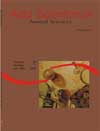<strong>Qualidade de ovos de codornas alimentadas com dietas que contém mananoligossacarídeos e níveis reduzidos de cálcio</strong> - DOI: 10.4025/actascianimsci.v30i3.512
Resumo
Avaliaram-se os efeitos de dietas que contém mananoligossacarídeo (MOS) e níveis de cálcio (Ca) sobre qualidade dos ovos de codornas. Foram utilizadas 200 codornas em delineamento inteiramente casualizado em arranjo fatorial 2 x 2 + 1 (níveis de Ca x MOS e uma dieta-controle), com quatro repetições. Os tratamentos eram níveis de Ca (2,2 e 1,9%) e de MOS (0 e 0,1%) e a dieta-controle (sem MOS e com 2,5% de Ca). Foram estudadas as qualidades internas (peso e índice de gema e de albúmen e unidade Haugh) e externas (peso, teor de Ca e espessura da casca e gravidade específica) do ovo de codornas. Não houve efeito (p > 0,05) dos tratamentos sobre pesos e índices de gema e albúmen, unidade Haugh, peso e espessura da casca. Entretanto, a inclusão de MOS aumentou (p < 0,02) o teor de Ca nas cascas em 2,75%, e a redução do teor de Ca dietético diminuiu (p < 0,01) a gravidade específica dos ovos de codornas alimentadas com dietas contendo 1,9% de Ca. Concluiu-se que dietas com 2,2% de cálcio, suplementadas com 0,1% de MOS, podem ser utilizadas por codornas japonesas, em fase inicial de postura, sem prejuízo à qualidade do ovo.Downloads
DECLARAÇÃO DE ORIGINALIDADE E DIREITOS AUTORAIS
Declaro que o presente artigo é original, não tendo sido submetido à publicação em qualquer outro periódico nacional ou internacional, quer seja em parte ou em sua totalidade.
Os direitos autorais pertencem exclusivamente aos autores. Os direitos de licenciamento utilizados pelo periódico é a licença Creative Commons Attribution 4.0 (CC BY 4.0): são permitidos o compartilhamento (cópia e distribuição do material em qualqer meio ou formato) e adaptação (remix, transformação e criação de material a partir do conteúdo assim licenciado para quaisquer fins, inclusive comerciais.
Recomenda-se a leitura desse link para maiores informações sobre o tema: fornecimento de créditos e referências de forma correta, entre outros detalhes cruciais para uso adequado do material licenciado.








































